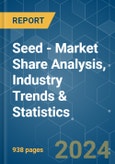The Seed Market size is estimated at USD 73.13 billion in 2024, and is expected to reach USD 100.13 billion by 2030, growing at a CAGR of 5.38% during the forecast period (2024-2030).
Key Highlights
- Largest Segment by Crop Family - Grains & Cereals : It is the largest segment as it provides high profit for growers, high consumption as food, and an increase in the demand by the lubricants industry for biofuel production.
- Largest Segment by Country - United States : It is a leading producer of high-value crops such as corn, soybean, and cucumber, and the adoption of biotech crops, as well as hybrid seeds is the highest globally.
- Fastest-growing Segment by Crop Family - Roots & Bulbs : It is the fastest growing due to the increase in market value, increase in the demand by processing industries, and the availability of high-yielding varieties in the market.
- Fastest-growing Segment by Country - Italy : It is the fastest growing because of the increase in the consumption of salad, the leading producer of peas globally, and the increase in the demand for feed by dairy farmers.
Seed Market Trends
Hybrids is the largest Breeding Technology
- The growing demand for hybrid and open-pollinated seeds from organic growers, animal feed, food, and biofuel industries is driving the market's growth.
- Hybrid seeds have witnessed high growth, mainly from the major agriculture-producing countries, because of their various benefits, including higher productivity, wider adaptability, and a high degree of resistance to biotic and abiotic stresses. For instance, in cotton, hybrids give 50% more yield than conventional varieties. Their wider adaptability is mainly due to their high buffering capacity to environmental fluctuations.
- New plant breeding techniques are allowing the development of new plant varieties with desired traits by modifying the DNA of the seeds and plant cells. Innovations in plant breeding are helping address the challenges farmers face in the field every day.
- Companies are heavily investing in new plant technologies due to the increasing demand for advanced improved varieties that are adaptable to different climatic conditions, have high yield potential, are resistant to diseases, and are drought tolerant. For instance, in 2020, Bayer opened its first fully automated greenhouse in Marana, Arizona, which includes innovative advancements in proprietary seed chipping, advanced marker technology, automation, and data science.
- Adopting improved open-pollinated varieties has many benefits, such as high yield, being well adapted to the local environment, and allowing crops to grow stronger. Due to the increase in demand, the share value of OPV increased by 4.1% in 2021 from the previous year.
North America is the largest Region
- Globally, Asia-Pacific is the largest agricultural region in terms of production, which holds the major share in the global seed market due to the increase in area under major crops and the increase in seed replacement rate. For instance, the area harvested in cereals increased to 341 million hectares in 2020 from 333 million hectares in 2019.
- North America is one of the world's leading seed-producing regions. The United States is the largest seed market, with corn contributing a major share and accounting for 52.8% of the US seed market in 2021. This is mainly because of the adoption of biotech crops.
- Europe is a major producer of forages, with a share value of 32.7% in the global forage seed market in 2021. Major driving factors of the forage seed market include growing demand for feed products and shrinking land for grazing animals.
- In Africa, row crops held the largest share, accounting for 79.2% in 2021. The main reason for holding the major share of row crops is the increasing consumption with an increasing acreage under cultivation.
- South America's hybrid adoption rate is expected to be more than that of open-pollinated seed varieties from 2022 to 2028 because of an increase in the yield by 10-15%, good quality, and better return on investment. Therefore, hybrid seeds are expected to increase by 38.7% from 2021 to 2028.
- The seed market in the Middle East is expected to grow moderately from 2022 to 2028 because of the lower usage of hybrid seeds in the Middle East. The growers are not interested in using transgenic seeds, and to meet domestic demand, they must import about 30-50% of crops from other countries.
Seed Industry Overview
The Seed Market is fragmented, with the top five companies occupying 38.08%. The major players in this market are BASF SE, Bayer AG, Corteva Agriscience, KWS SAAT SE & Co. KGaA and Syngenta Group (sorted alphabetically).Additional Benefits:
- The market estimate (ME) sheet in Excel format
- 3 months of analyst support
Table of Contents
1 EXECUTIVE SUMMARY & KEY FINDINGS2 REPORT OFFERS7 KEY STRATEGIC QUESTIONS FOR SEEDS CEOS
3 INTRODUCTION
4 KEY INDUSTRY TRENDS
5 MARKET SEGMENTATION
6 COMPETITIVE LANDSCAPE
8 APPENDIX
Companies Mentioned (Partial List)
A selection of companies mentioned in this report includes, but is not limited to:
- Advanta Seeds - UPL
- BASF SE
- Bayer AG
- Corteva Agriscience
- DLF
- Groupe Limagrain
- KWS SAAT SE & Co. KGaA
- Rijk Zwaan Zaadteelt en Zaadhandel BV
- Sakata Seeds Corporation
- Syngenta Group
Methodology

LOADING...










